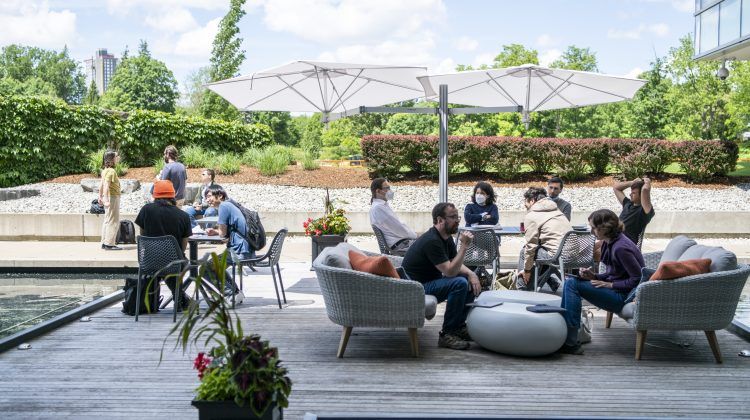Fascinating stories from the world’s largest scientific gathering

This week, Boston became a global epicentre of big ideas, from black holes to boosting brainpower, from robotic bugs to preventing pandemics.
Thousands of scientists, journalists, and policymakers assembled for the Annual Meeting of the American Association for the Advancement of Science (AAAS), the largest scientific gathering on Earth.
A recurring theme of the conference was that pioneering science is more important than ever, at a time when humanity needs breakthroughs to tackle global challenges, and when a tide of anti-scientific sentiment seems on the rise.
Here’s a look at just some of the research highlighted during the conference.
An unprecedented eyepiece on the universe
During a press breakfast co-hosted by Perimeter Institute, astrophysicist Avery Broderick (Perimeter Institute and University of Waterloo) provided journalists with an overview of the Event Horizon Telescope (EHT). The global array of interconnected telescopes will be fully online this April, and is expected to soon obtain humanity’s first image of a black hole, probing fundamental questions of spacetime in the process.
Broderick was joined by researchers from several other leading Canadian research institutes, each of whom discussed how their research bridges theory and experiment to make important discoveries at the intersections of disciplines. Paul Schaffer of TRIUMF described the development of isotopes to diagnose and treat disease; Chithra Karunakaran of Canadian Light Source described the synchrotron techniques for agriculture research; and Erica Caden of SNOLAB described a variety of research projects happening in her facility’s shielded environment two kilometres underground.
Radioactive garbage from your lab turns out to be a potential cancer treatment
During his talk at the press breakfast, Paul Schaffer of TRIUMF described how the radioactive waste a lab had been stockpiling was actually a rare and potentially cancer-destroying medical isotope. Although TRIUMF largely focuses on nuclear physics, it also has a Life Sciences division, which Schaffer oversees. He and his team realized their research had a valuable byproduct: the isotope actinium, which has been shown to destroy tumours.
Read more on Motherboard, and watch Schaffer’s 2016 Perimeter Institute Public Lecture on the subject:
How space weather can influence elections
The Sun apparently tinkers with voting on Earth, according to a presentation given by Bharat Bhuva, a professor of electrical engineering at Vanderbilt University. In one small-town election in Belgium, an extra 4,000 votes were cast on electronic voting machines due to cosmic rays bouncing off a vulnerable node in the machine’s register, causing it to flip a bit and log the additional votes. Read more on Motherboard.
Special gait helps this six-legged robot outpace insects
Researchers have discovered a simple way to make insects faster: change the way they run. Usually, speeding insects have three legs on the ground at once — a so-called tripod gait — whereas horses and other vertebrates hit their top speeds with just two legs on the ground. So robotics researchers tried the two-footed approach with speedy results. Read more.
Want to repel mosquitoes? Don’t use citronella candles
In a recent study, a (brave) volunteer sat as “bait” to test the effectiveness of nearly a dozen different mosquito repellent techniques, from sprays to high-frequency sounds. Most repellents did not live up to the promises on their labels. Read more.
Weird life found trapped in giant underground crystals
Creatures that thrive on iron, sulfur, and other chemicals have been found trapped inside giant crystals deep in a Mexican cave. The microbial life-forms are most likely new to science, and are still active after thousands of years of slumber.
“These organisms have been dormant but viable for geologically significant periods of time, and they can be released due to other geological processes,” says NASA Astrobiology Institute director Penelope Boston.
Read more on National Geographic, and watch an interview with Penelope Boston recorded at Perimeter Institute:





















































































